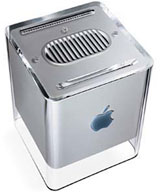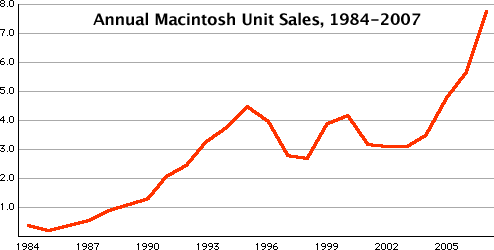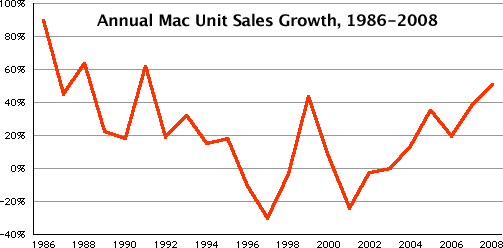Mac Musings
50% Mac Sales Growth Is Only the Beginning
Daniel Knight - 2008.05.02 -
Let's give some serious thought to the possible configuration of a midrange Mac, the computer Apple could conceivably produce to kill off the Psystar Open Computer and take on the most popular type of Windows PC, the minitower.
History
Ever since the introduction of the Macintosh LC in 1990, Apple has traditionally had high-end, low-end, and midrange desktop Macs - usually three distinct models. Today that would be the Mac Pro at the top, the Mac mini at the bottom, and the iMac in the middle.
This whole scheme was messed up when Apple discontinued the Performa line and eliminated the Power Mac 6500, the last modular consumer desktop before the Mac mini, in March 1998. This was the era of the Beige Power Mac G3, Apple's one-and-only desktop model until the iMac hit the market in August 1998.
 From
November 1997 through the present, the only modular Macs with expansion
slots were the 3- and 4-slot Power Macs and Mac Pros - with one
exception. That was the Power Mac G4 Cube, which was a
work of art, a decently powered computer, somewhat flawed in design
(you had to lift up the computer to access the USB ports!), and
seriously limited in the expandability department. It had an AGP 2x
video card, which could be replaced, but not a single PCI slot.
From
November 1997 through the present, the only modular Macs with expansion
slots were the 3- and 4-slot Power Macs and Mac Pros - with one
exception. That was the Power Mac G4 Cube, which was a
work of art, a decently powered computer, somewhat flawed in design
(you had to lift up the computer to access the USB ports!), and
seriously limited in the expandability department. It had an AGP 2x
video card, which could be replaced, but not a single PCI slot.
Function followed form, and while people raved about the Cube's beauty, it was almost universally panned for offering so little value compared to the "regular" Power Mac G4. For about the same price, you could have a beautiful 450 MHz Cube with no PCI slots and no empty drive bays or a 400 MHz minitower with 3 PCI slots, 3 internal hard drive bays, and room for a full-sized AGP video card.

In a year when Apple sold about 4 million Macs, only 150,000 of them were Cubes, and the Cube was put on ice a year after it was introduced while the consumer iMac and more pro-oriented Power Macs were selling very nicely.
Change
When he announced the iMac a decade ago, Steve Jobs introduced the Mac Matrix, a four quadrant marketing plan. There would be consumer and pro Macs in both desktop and notebook models. Nothing in between, which was part of the Cube's problem: It didn't fit the matrix.
Over time the iMac became a more costly, more midrange solution. After the flat panel G4 iMac moved the "consumer" model out of the reach of many consumers, Apple introduced the more affordable, CRT-based eMac, creating a new low end and redefining the iMac as Apple's midrange desktop solution.
At the same time, the Power Mac line generally had 3 or 4 models (for a brief time during the Digital Audio era, 5!), and the low-end Power Mac was reasonably priced in comparison to the iMac. Here are some comparisons of the lowest cost iMacs and "pro" Macs:
- 2002: 15" iMac G4/700 MHz, $1,299; Quicksilver 2002 Power Mac G4/800 MHz, $1,599
- 2003: 15" iMac G4/1 GHz, $1,299; MDD Power Mac G4/1.25 GHz, $1,299
- 2004: 17" iMac G5/1.6 GHz, $1,299; Power Mac G5/1.8 GHz, $1,499
- 2005: 17" iMac G5/1.9 GHz, $1,299; Power Mac G5/2.0 GHz Dual, $1,999
- 2006: 17" iMac Core Duo 1.83 GHz, $1,299; Mac Pro 2.0 GHz dual, $2,199
- 2008: 20" iMac Penryn 2.4 GHz, $1,199; Mac Pro 2.8 GHz quad, $2,199
Apple has done a great job of keeping the entry-level iMac at the same price point since introducing the flat panel G4 iMac in 2002 - interestingly exactly the same $1,299 retail price as the original 1998 iMac. At the same time, the price difference between the most affordable iMac and the most affordable desktop Mac with expansion slots has grown from $300 in 2002 to a whopping $1,000 today.
Today's Macs
I'm not faulting the Mac Pro. With the name change, Apple has felt free to design a no-holds-barred production tool for graphics and video professionals - fast SATA hard drives, room for two SuperDrives, slots for lots of very fast RAM, PCIe expansion slots, and up to 8 processing cores.
I'm not faulting the iMac. Apple reintroduced the all-in-one desktop personal computer with the first Macintosh in 1984 and completely refreshed it with the first iMac in 1998. Apple perfected the design with the first slim G5 iMac in 2004, and empowered it with dual-core Intel CPUs. And with the exception of the 18-bit display on the 20" aluminum iMac, Apple has offered excellent displays to complement the rest of the hardware.
I'm not faulting the Mac mini. Introduced three years ago as an entry-level modular Mac (the entry-level eMac was discontinued a few months later), it's a work of art. It's adequately powerful. The notebook hard drive is sufficient. And the RAM limitations aren't unreasonable for its intended market. In fact, today's entry-level $599 Mac mini will run circles around any Power Mac, with the possible exception of the $3,300 Power Mac G5 Quad. Not bad for a 2" high computer at less than 1/5 the price!
The Missing Piece
As I sit here in front of my 19" 1280 x 1024 Dell flat panel display, typing on my Logitech Cordless Keyboard and working on my dual 1 GHz Power Mac G4 from 2002, I know what's missing from Apple's desktop line: a prosumer* modular desktop.
We have the consumer side covered with the Mac mini and the 20" iMac. We have the pro side covered with the aptly named Mac Pro. And we have the all-in-one prosumer market covered with the 24" iMac. But there is no modular Mac for prosumers.
Entry-level Power Macs used to meet that need, but as the above comparisons demonstrate, the price of a Mac with expansion slots has increased by $900 since its low point in 2003.
Why a Prosumer Mac?
There are a number of reasons for Apple to build a midrange modular Mac for the prosumer market.
- Prosumers love to tinker and upgrade. They want expansion slots and drive bays.
- Prosumers don't need the flat-out performance provided by quad-core processors, although they definitely want the option.
- Prosumers want more choices in memory configurations, video cards, hard drives, monitor size, processors, etc. than pros need.
- The bulk of Windows users - the potential switcher market - is used to minitowers.
- The bulk of Windows geeks and gurus - the people others ask for buying advice - are prosumers.
- The 18-bit display in the 20" iMac and lack of smaller models. Many users already have monitors they are happy with, want a true 24-bit display smaller than 24", want something smaller than 20", etc.
Apple has already ratcheted its growth rate up from 20% two years ago to 30% last year and 50% so far this year. The company has great hardware, an awesome operating system, and many excellent Mac-only applications, several of which come free with new Macs. Apple has grown to #4 in the US market, where it's a significant player in the notebook realm but has a much lower share in the desktop market.

Apple is ahead of the curve in that respect. The overall PC industry isn't expected to become 50% notebook until next year, but Apple hit that point some time ago.
That's not necessarily a good thing. Yes, Apple makes excellent MacBooks, and they sell very well, but part of the reason portables so dominate Apple sales is the gaping hole in the desktop line where a prosumer midrange Mac should sit.
Prosumer Options
A lot of us have been thinking about this for a long time, and we're pretty much agreed that such a Mac must have at least two expansion slots, two hard drive bays, room for lots of RAM, and have a socketed CPU so the end user can upgrade it. Beyond that, we have different ideas.
First off, we don't want this to be a crippled Mac Pro (the next gen Road Apple) or a souped-up Mac mini. It has to have its own identity. It has to be designed from the ground up to be a Mac and to meet the needs of the prosumer market. And it has to be modern; as there have been no prosumer minitower Macs since the G4 era, we don't need legacy compatibility with IDE hard drives, PCI or AGP video cards, etc.
The prosumer minitower should have 2 or 3 PCIe slots and have room for full-sized cards. It should support dual-core and quad-core CPUs, but it doesn't have to support multiple CPUs. It should have two 3.5" hard drive bays and probably two optical drive bays. Some USB ports and at least one FireWire port should be accessible from the front. It should have an internal power supply, and Bluetooth plus 802.11n WiFi should be built in. And, whatever this means to Steve Jobs and Jonathan Ive, it should look like a Mac.
My preference would be for two different desktop cases, a minitower and a traditional under-the-monitor design, both using the same motherboard. Apple did this with the Quadras, Power Mac 7100/8100, and Power Mac G3. It was a great idea then and remains a great idea today.
I would design a single motherboard that supports integrated graphics, but I would make that GPU optional. Users who don't need powerful video could buy it with Intel X3100 graphics (as used in the MacBook) and have the option of adding a video card later. Users who know they want or need better graphics could buy it without the Intel GPU.
For gamers, Apple should make sure that at least the better video cards include Cross Fire support, a way of tying two video cards together. And video card options should run the range from pedestrian (for people who just want an extra display or two) to high-end: every video card available for the Mac Pro should be available with the prosumer model.
Memory should be expandable to 8 GB, which seems like overkill today but will seem pedestrian five years from now. Processor options should range from 2.0 GHz dual-core to 3.0 GHz quad-core. And it should include Leopard and the full complement of software included with the iMac and Mac mini.
For the price conscious, Apple could offer a 2.0 GHz Penryn model with 1 GB of RAM, integrated graphics, a 250 GB hard drive, and a Combo drive. Apple could get away with selling this for $699 or even $799, as it would be far more expandable than the $599 1.83 GHz Mac mini, which also includes a Combo drive. Or it could price it based on the lower cost of desktop drives compared with the notebook drives used in the Mac mini, which means it could easily retail for $599. (That would put an end to Psystar's Open Computer, which is $695 with 2 GB of RAM, Leopard, FireWire, WiFi, and a SuperDrive.)
As with the Mac mini, the next step up should include a faster CPU (probably the same 2.4 GHz as the iMac), a SuperDrive, a bigger hard drive (320 MB, like the iMac), and sell for $200 more. And, while we're at it, double RAM to 2 GB.
From here, the sky's the limit. Apple could offer 2.8 GHz and 3.0 GHz dual-core and quad-core options, several video card choices (ATI Radeon HD 2600 XT at $130 each, Nvidia GeForce 8800 GT at $280, Nvidia Quadro FX 5600 at $2,980, and hopefully several others as well), a second hard drive and optical drive, lots of different RAM configurations, an option for a GPU-free motherboard, and the whole range of Apple Cinema Displays.
And if Apple follows the low cost pricing scheme, make the mouse and keyboard optional, as with the Mac mini.
Can you say cash cow?
Finally - and here's the thing I never expect to see from Apple - offer a bare bones configuration. Very bare bones: case, power supply, motherboard, and the OS/software bundle. No CPU. No RAM. No GPU. No hard drive. No optical drive. No mouse. No keyboard. No one-year warranty - make it 90 days on the bare bones machine and offer a full year of coverage for $75, 3-year AppleCare for $200.
This is what I'd expect the basic configurations to sell for:
- Bare bones, $299 with build-to-order options including Intel X3100 graphics, CPUs, RAM, video cards, etc.
- 2.0 GHz Penryn, $599 with 1 GB of RAM, 250 GB hard drive, Combo drive, Intel X3100 graphics.
- 2.4 GHz Penryn, $799 with 2 GB of RAM, 320 GB hard drive, SuperDrive, X3100 graphics.
- 2.8 GHz Penryn, $1,199 with 2 GB of RAM, 320 GB hard drive, SuperDrive, Nvidia GeForce 8800 GT graphics (no X3100 graphics).
- 3.0 GHz quad-core, $1,599 with 2 GB of RAM, 500 GB hard drive, SuperDrive, GeForce 8800 GT.
These are ballpark figures, but I think they are realistic. And while hobbyists would flock to the bare bones model, the vast majority of users would prefer to buy something ready to use, so I wouldn't expect it to account for more than 10% of overall sales. Best of all, Apple could probably count on everyone who goes the bare bones route helping several others make the decision to go Mac.
Icing on the cake for switchers? Make a deal to offer Fusion or Parallels for next to nothing after a mail-in rebate. Then they can have their Windows and use it too - on their new Macintosh while discovering the joys and power of Mac OS X.
Of course, a model like this would upset the notebook-dominated apple cart, making desktops a bigger part of the Mac market and potentially bringing in droves of new customers.And that will also help sell iMacs, as PC users realize that the Mac really is an alternative, their old displays may as well be replaced with a widescreen display, and they probably don't need all those expansion options their PCs have had (and they haven't really used).
When that happens, last quarter's 50% growth in unit sales will look like just the start of a trend.
* In the photographic realm, where the term originated, prosumer gear is a significant step up from the typical price conscious consumer gear but not of the same caliber as the quality-regardless-of-cost pro equipment. The term is a hybrid of producer and consumer, indicating an individual who uses equipment heavily but doesn't need as much as pros. A lot of hobbyists and gamers fit the prosumer category.